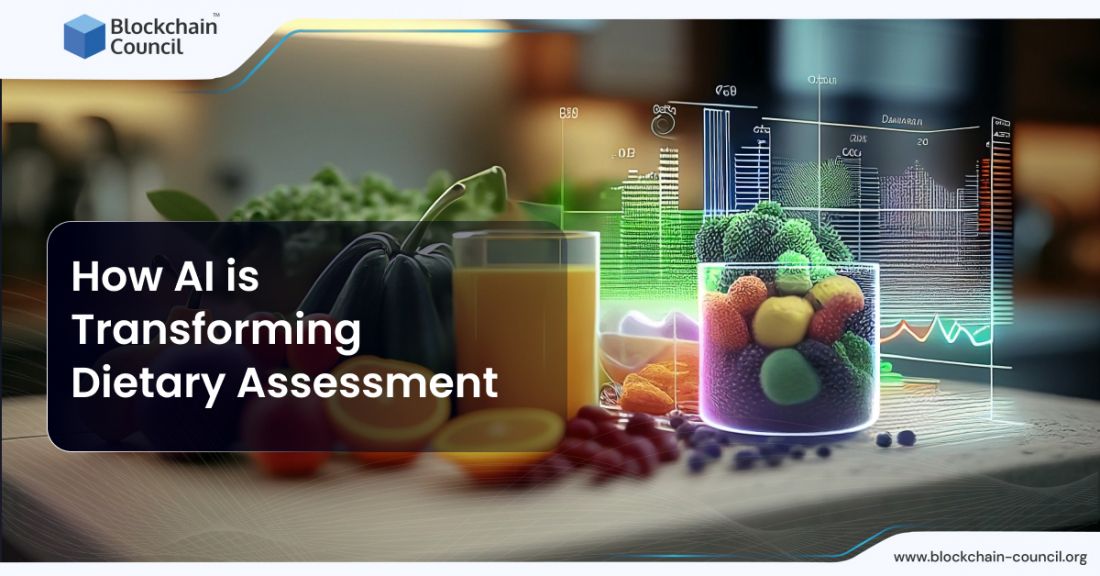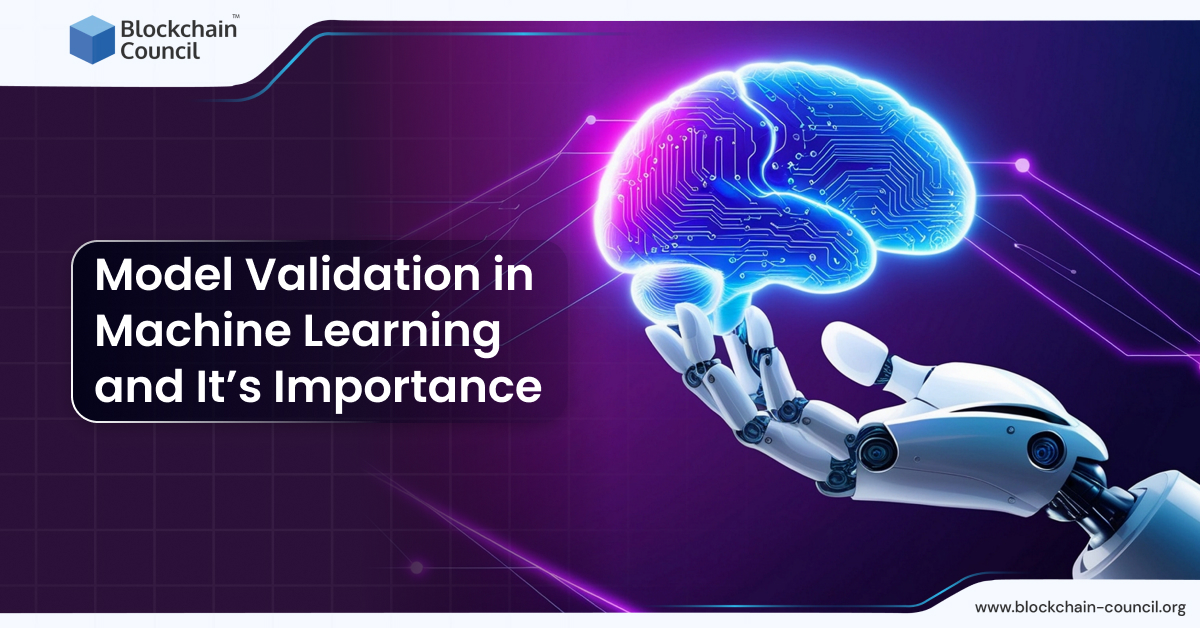
- Blockchain Council
- October 31, 2023
Summary
- Traditional dietary assessment methods have limitations, including reliance on memory and self-reporting, leading to inaccuracies in data.
- Artificial Intelligence (AI) is offering solutions to these challenges by revolutionizing dietary assessment.
- AI uses machine learning algorithms and image recognition to analyze food images, predict portion sizes, and estimate nutrient content with high accuracy.
- AI-powered mobile apps and wearables provide real-time dietary feedback and personalized recommendations.
- AI not only enhances data accuracy but also streamlines the assessment process, making it less burdensome for participants.
- AI is transforming dietary assessment in research, clinical practice, and public health initiatives.
- Emerging technologies like AI-driven image recognition reduce the reliance on memory and self-reporting.
- Wearable sensor devices offer real-time monitoring, reducing recall bias and providing continuous data collection.
- Natural Language Processing (NLP) automates food logging, making it more user-friendly and accurate.
- AI-driven personalized dietary recommendations consider individual factors and goals, offering tailored nutrition plans and improving public health.
Introduction
Dietary assessment plays a pivotal role in understanding and improving human health. It provides critical insights into an individual’s nutritional intake, which is essential for addressing diet-related diseases, promoting healthier lifestyles, and optimizing nutrition interventions. However, traditional dietary assessment methods, such as self-reported food diaries and 24-hour recalls, are fraught with limitations. They rely heavily on individuals’ memory and honesty, often leading to underreporting or inaccuracies. These shortcomings hinder our ability to obtain precise dietary data, thereby impeding effective healthcare and nutrition strategies.
In recent years, the advent of Artificial Intelligence (AI) has offered a promising solution to the challenges of dietary assessment. AI, with its capacity for data analysis and pattern recognition, can transform the way we collect and interpret dietary information. Through machine learning algorithms and image recognition technology, AI can analyze images of meals, predict portion sizes, and estimate nutrient content with remarkable accuracy. Moreover, AI-powered mobile apps and wearable devices can provide real-time dietary feedback and personalized recommendations, empowering individuals to make healthier food choices.
The integration of AI in dietary assessment not only enhances data accuracy but also streamlines the process, making it less burdensome for participants. This holds tremendous potential for advancing public health initiatives, clinical research, and personalized nutrition plans. In this context, the following discussion explores the various applications and benefits of AI in dietary assessment, highlighting its potential to revolutionize how we monitor and manage dietary intake for the betterment of global health.
The Current State of Dietary Assessment
| Challenges with Traditional Methods | Potential Alternatives |
| Reliance on self-reporting | AI-powered image recognition technology can identify food items, reducing reliance on memory. |
| Recall bias | Wearable sensor devices provide real-time monitoring, reducing recall bias. |
| Inaccuracies in dietary data due to human factors | Continuous data collection through technology improves accuracy. |
| Social desirability bias | Objective data from technology reduces the impact of social desirability bias. |
| Barriers like literacy and motivation | User-friendly technology interfaces can overcome barriers for wider usage. |
| Limited representation of the broader population | Innovative solutions offer potential for more inclusive and accurate data collection. |
The current state of dietary assessment relies heavily on traditional methods, which have their own set of advantages and disadvantages. Traditional approaches, such as self-reported food diaries and 24-hour recalls, have long been the cornerstone of collecting dietary information for research, clinical practice, and public health interventions. These methods are relatively cost-effective and offer practical ways to gather dietary data from a large number of individuals. They have played a crucial role in understanding dietary patterns and forming the basis for nutritional recommendations. Additionally, they allow for a certain degree of participant autonomy in reporting their food intake, which can empower individuals to take control of their dietary habits.
However, traditional dietary assessment methods come with inherent limitations. One of the most significant challenges is the reliance on self-reporting, which involves individuals documenting their food intake based on memory and willingness to provide accurate information. This dependence on human recollection can lead to underreporting, overreporting, or inaccuracies in dietary data. People may forget to record certain meals or snacks, underestimate portion sizes, or omit less healthy food choices. Moreover, self-reported data can be influenced by social desirability bias, where individuals may alter their responses to align with perceived societal norms, leading to skewed results.
Recall bias is another pervasive issue in traditional dietary assessment. Participants may struggle to accurately remember and report their food consumption, particularly for infrequent or irregularly consumed items. This bias can affect the quality and reliability of dietary data, making it difficult to draw meaningful conclusions and potentially impacting the efficacy of nutrition interventions and public health policies. Additionally, these methods often require a high level of participant literacy and motivation, which can pose barriers to their widespread use and may result in biased samples that do not represent the broader population accurately.
Given these limitations, there is a compelling need for more accurate and objective approaches to dietary assessment. Emerging technologies offer promising alternatives that aim to overcome the challenges associated with traditional methods. For example, AI-powered image recognition technology can automatically identify and quantify food items in photographs, reducing the reliance on memory and self-reporting. Wearable sensor devices can monitor dietary intake in real-time, providing continuous data collection without the need for manual record-keeping. These technologies have the potential to improve data accuracy, reduce recall bias, and enhance the overall efficiency of dietary assessment. Furthermore, they can offer a more user-friendly experience, making it easier for individuals to track their dietary habits and receive personalized feedback and recommendations.
While traditional dietary assessment methods have played a valuable role in understanding dietary patterns, they are not without their limitations, including self-reporting and recall bias. These challenges highlight the need for more accurate and objective approaches to dietary assessment, which emerging technologies like AI and wearable sensors are striving to provide. By harnessing the potential of these innovative solutions, we can advance our understanding of dietary habits and their impact on health, ultimately leading to more effective nutrition interventions and improved public health outcomes.
Also Read- Top 10 IoT Technologies You Should Know In 2024
AI-Powered Image Recognition
AI-powered image recognition, driven by computer vision technology, plays a pivotal role in revolutionizing dietary assessment. This cutting-edge approach enables the automatic analysis of food images, allowing for a more accurate and efficient means of tracking dietary intake. AI algorithms are trained to recognize food items, estimate portion sizes, and calculate nutrient content from images captured by smartphones or other devices. Through the utilization of vast datasets and machine learning, these algorithms continuously improve their accuracy and reliability.
The advantages of AI-powered image recognition over traditional methods like manual food diaries and 24-hour recalls are significant. Firstly, it reduces the burden on participants by eliminating the need for meticulous record-keeping and memory-based reporting. Users can simply snap pictures of their meals, making the process more convenient and less prone to recall bias. Secondly, AI can provide real-time feedback and nutritional analysis, empowering individuals to make informed dietary choices instantly. Additionally, AI-driven dietary assessment offers the potential for personalized recommendations, catering to an individual’s specific nutritional needs and goals. Overall, AI-powered image recognition represents a transformative shift in the field of dietary assessment, promising greater accuracy, efficiency, and user-friendliness, while minimizing the limitations associated with traditional methods.
Wearable Devices and Sensor Technology
The integration of AI-enabled wearables and sensor technology is ushering in a new era of dietary monitoring and personalized nutrition. These innovative devices, ranging from smartwatches to ingestible sensors, offer real-time data collection capabilities that provide invaluable insights into an individual’s food intake and nutritional habits. Utilizing a combination of sensors like accelerometers, gyroscopes, and optical sensors, these wearables can track movements, recognize hand-to-mouth gestures, and even analyze chewing patterns. This wealth of data allows for precise measurement of food intake, portion sizes, and meal composition.
One of the most significant advantages of AI-enabled wearables is their ability to collect data in real-time, offering immediate feedback and encouraging mindful eating. Users can receive alerts or notifications about their dietary choices, helping them make healthier decisions in the moment. Moreover, this technology enables the continuous monitoring of nutrition, helping individuals maintain a more accurate picture of their overall dietary habits over time. The potential for personalized nutrition recommendations and interventions based on this real-time data is immense, allowing for targeted strategies to address specific dietary goals or health conditions. AI-enabled wearables and sensor technology are thus poised to transform the way we monitor and manage our diets, promoting healthier lifestyles and improved well-being.
Also Read- Role Of Artificial Intelligence In Smart Food Supply Chains
Natural Language Processing (NLP) for Food Logging
Natural Language Processing (NLP) is a game-changer in the realm of food logging and dietary assessment. This technology has the power to transform the way individuals journal their food intake by converting text-based descriptions into valuable dietary insights. NLP algorithms can analyze and interpret food-related text, identifying specific food items, portion sizes, and even cooking methods mentioned in descriptions or restaurant menus. This automated process not only reduces the burden on users who may find manual food logging tedious but also significantly enhances the accuracy of dietary data collected.
NLP’s ability to extract meaningful insights from text-based dietary data opens up new avenues for research, healthcare, and personal nutrition management. It can identify dietary patterns, track nutrient intake, and recognize potential allergens or intolerances mentioned in food descriptions. By making food journaling more accessible and user-friendly, NLP encourages more individuals to engage in tracking their diets, which can be instrumental in promoting healthier eating habits and managing chronic conditions. In essence, NLP is revolutionizing food logging by bridging the gap between textual data and actionable dietary insights, ultimately improving the accuracy, convenience, and impact of dietary assessment for users, researchers, and healthcare professionals alike.
Also Read- Top 5 Generative AI Models To Watch Out For In 2024
Personalized Dietary Recommendations
Personalized dietary recommendations, powered by artificial intelligence (AI), represent a groundbreaking approach to nutrition that harnesses individual data to create tailored diet plans. These recommendations are rooted in a comprehensive analysis of factors such as an individual’s age, gender, activity level, genetic makeup, dietary history, and specific health goals or preferences. AI algorithms process this information to craft highly customized nutrition strategies that optimize nutrient intake, promote weight management, address dietary deficiencies, and cater to dietary restrictions or preferences, whether it be for weight loss, muscle gain, managing chronic conditions, or achieving overall well-being.
The potential impact of personalized nutrition on public health is immense. By tailoring diets to each person’s unique requirements and goals, AI-driven recommendations have the power to significantly improve dietary adherence and long-term health outcomes. They empower individuals to make informed choices aligned with their specific needs, making healthy eating more achievable and sustainable. Furthermore, personalized nutrition can contribute to reducing the prevalence of diet-related diseases like obesity, diabetes, and cardiovascular conditions, thus alleviating the burden on healthcare systems and improving overall well-being on a population scale.
In essence, the advent of AI-driven personalized dietary recommendations is poised to reshape the way we approach nutrition, offering a paradigm shift from one-size-fits-all dietary guidelines to precise, data-driven nutrition plans that cater to the individual. As these technologies continue to evolve and become more accessible, they hold the promise of transforming public health by providing individuals with the tools and knowledge to take control of their diets and lead healthier, more fulfilling lives.
Overcoming Challenges and Concerns
As we delve into the promising realm of AI-powered dietary assessment, it is crucial to confront and mitigate the challenges and concerns that accompany this technological advancement. Ethical considerations loom large, as the collection and analysis of personal dietary data raise questions about consent, data ownership, and the potential for exploitation. Striking the right balance between harnessing AI’s potential and respecting individuals’ rights to privacy and autonomy is imperative.
Privacy issues and data security are paramount concerns in the age of AI-driven dietary assessment. The vast amount of personal information, including food preferences, health conditions, and eating habits, collected by these systems demands rigorous safeguards. Protecting this data from breaches, misuse, or unauthorized access is essential to ensure users’ trust and uphold their privacy rights. Furthermore, transparency in data handling practices and clear consent mechanisms should be established to foster a sense of control and confidence among users.
Another challenge lies in addressing disparities and biases in AI algorithms used for dietary assessment. If not carefully designed and tested, these algorithms may inadvertently perpetuate existing health disparities, as they rely on historical data that may reflect biases in healthcare or dietary practices. Ensuring that AI systems are trained on diverse and representative datasets is crucial to prevent unfair or inaccurate outcomes. Continuous monitoring and auditing of AI algorithms to identify and rectify biases must be a priority to promote fairness and equity in dietary assessment.
Moreover, there is a need for robust regulation and oversight to govern AI-powered dietary assessment systems. Regulatory bodies must establish clear guidelines on data handling, security, and algorithm fairness while promoting ethical practices among developers and service providers. Collaboration between experts from diverse fields, including nutrition, ethics, and technology, is essential to strike the right balance between innovation and ethical responsibility.
Also Read- How Can Developers Use Google Bard?
Case Studies and Success Stories
Case studies and success stories from the application of AI-driven dietary assessment underscore the transformative potential of this technology across various domains. In the realm of research, AI has expedited data collection and analysis, enabling researchers to gather comprehensive dietary information on a large scale. For instance, studies using image recognition technology have showcased how AI accurately identifies food items and portion sizes from photos, revolutionizing nutritional research methodologies.
In healthcare, AI-powered dietary assessment has facilitated more precise and personalized interventions. Healthcare providers can now offer tailored dietary recommendations based on real-time data, empowering patients to make healthier choices and manage chronic conditions effectively. For example, individuals with diabetes can benefit from AI-driven apps that track their carbohydrate intake and offer personalized insulin dosage recommendations.
On the consumer front, AI-driven dietary apps and wearables have become indispensable tools for wellness enthusiasts. These technologies offer users real-time insights into their dietary habits, encouraging healthier choices and fostering long-term lifestyle changes. Success stories of individuals achieving their weight loss or fitness goals through AI-guided nutrition plans are becoming increasingly common.
Lessons learned from these case studies emphasize the importance of user-friendly interfaces, data accuracy, and privacy protection. Successful AI-driven dietary assessment tools prioritize usability, ensuring that individuals can easily incorporate them into their daily routines. Additionally, data accuracy is paramount, as even small errors can lead to significant health consequences. Moreover, maintaining stringent data security and privacy measures is essential to earn and maintain users’ trust.
Looking ahead, the possibilities for AI in dietary assessment are vast. Continued advancements in machine learning, sensor technology, and data analytics promise to enhance the accuracy and scope of dietary assessment even further. Personalized nutrition plans based on AI analysis may become the standard in healthcare, offering tailored strategies for disease prevention and management. In research, AI can help uncover complex dietary patterns and their impact on health outcomes, driving breakthrough discoveries.
Also Read- 5 Must-Have AI Skills In 2024
The Future of AI in Dietary Assessment
| Aspects | Summary |
| AI Algorithm Refinement | AI algorithms are becoming more accurate and efficient for better dietary assessment. |
| Technology Advancements | AI leverages computer vision, sensors, and NLP to interpret dietary data from images, wearables, and text. |
| Personalized Nutrition | AI creates custom diet plans based on individual health goals, preferences, and genetics. |
| Healthier Eating Habits | AI promotes healthier choices through apps, gamification, and behavior change techniques. |
| Public Health Impact | AI can identify dietary trends on a societal level, informing public health policies. |
The future of AI in dietary assessment is a landscape teeming with innovation, driven by emerging trends and technologies poised to reshape how we understand, manage, and optimize our diets. One prominent trend is the continued refinement of AI algorithms, which are becoming more accurate, efficient, and accessible. Advancements in computer vision, sensor technology, and natural language processing will enable AI to better recognize, track, and interpret dietary data from various sources, including images, wearable devices, and textual descriptions. Moreover, the integration of AI with genomics and microbiome analysis holds the potential to provide highly personalized nutrition recommendations, accounting for an individual’s unique genetic makeup and gut microbiota.
AI’s transformational potential in dietary recommendations cannot be overstated. With its ability to process vast datasets and extract nuanced insights, AI can craft highly customized diet plans that cater to individual health goals, dietary preferences, and specific nutritional needs. This personalization not only enhances dietary adherence but also fosters more effective strategies for weight management, disease prevention, and overall well-being. AI can empower individuals to make informed food choices, not just based on calorie counts, but also considering broader factors like nutrient balance, allergens, and sustainability, aligning diets with both personal and planetary health.
Beyond personalized nutrition, AI is poised to play a pivotal role in promoting healthier eating habits on a broader scale. Through AI-powered educational apps, gamification, and behavior change techniques, individuals can receive real-time feedback and guidance to make healthier choices. AI can also assist healthcare providers in delivering more effective dietary interventions, leveraging predictive analytics to identify at-risk populations and tailor interventions accordingly. Additionally, AI’s capacity for data analysis can uncover hidden dietary patterns and trends in population-wide data, informing public health policies and interventions that address diet-related diseases on a societal level.
Conclusion
In conclusion, the transformative potential of AI in dietary assessment is nothing short of revolutionary. It has already begun reshaping how we understand, monitor, and optimize our diets, with a trajectory that promises even greater advancements in the years ahead. Through AI-powered image recognition, sensor technology, and natural language processing, dietary assessment is becoming more accurate, convenient, and accessible. It empowers individuals with personalized nutrition recommendations, promoting healthier eating habits and facilitating disease prevention and management.
The path forward for research, industry, and healthcare is paved with exciting opportunities. Researchers can harness AI to unlock intricate dietary patterns and their impacts on health, leading to groundbreaking discoveries. In the food industry, AI can foster product development aligned with consumer preferences and dietary needs, ushering in an era of healthier, more sustainable food choices. In healthcare, AI-driven dietary assessment will enable more precise and individualized interventions, improving patient outcomes and reducing healthcare costs.
FAQs
How is AI used in nutrition and dietetics?
- AI is used in nutrition and dietetics to enhance dietary assessment methods and improve the accuracy of data collection.
- AI-powered image recognition can automatically analyze food images, estimate portion sizes, and calculate nutrient content with high precision.
- Wearable sensor devices and mobile apps with AI can provide real-time feedback, personalized recommendations, and continuous monitoring of dietary habits.
- AI is also used for natural language processing (NLP) to automate food logging by converting text-based descriptions into dietary insights.
What does AI mean in diet?
- AI in diet refers to the application of Artificial Intelligence in the field of dietary assessment and nutrition.
- It involves using machine learning algorithms, image recognition, sensor technology, and NLP to collect and analyze dietary data with high accuracy and efficiency.
- AI in diet aims to improve data accuracy, reduce reliance on memory and self-reporting, and provide personalized dietary recommendations.
What is the future of AI in dietary assessment?
- The future of AI in dietary assessment is marked by ongoing advancements in AI algorithms and technology.
- AI will continue to refine dietary assessment methods, becoming more accurate, efficient, and accessible.
- It will play a significant role in personalized nutrition, crafting highly customized diet plans based on individual health goals, preferences, and genetics.
- AI will promote healthier eating habits on a broader scale through apps, gamification, and behavior change techniques.
- AI’s impact on public health is expected to grow as it identifies dietary trends and informs policies to address diet-related diseases on a societal level.
What is the role of AI in dietary assessment?
- AI’s role in dietary assessment is to enhance the accuracy and efficiency of data collection.
- It reduces reliance on self-reporting by using image recognition and sensor technology to monitor dietary intake in real-time.
- It automates food logging through NLP, making it more user-friendly and accurate.
- AI plays a crucial role in providing personalized dietary recommendations based on individual factors, improving dietary adherence and overall well-being.
- It also informs public health initiatives by identifying dietary patterns and trends in population-wide data.





































































 Guides
Guides News
News Blockchain
Blockchain Cryptocurrency
& Digital Assets
Cryptocurrency
& Digital Assets Web3
Web3 Metaverse & NFTs
Metaverse & NFTs
